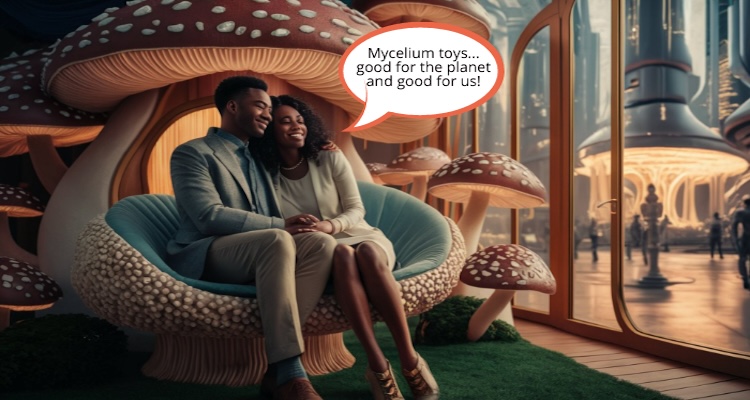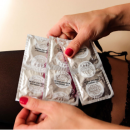Forest Floor to Bedroom Drawer: The Promise of Mushroom-Based Sex Toys
How next-gen mycelium bioplastics might someday give us sustainable pleasure devices

Mushroom experts like Paul Stamets say mushrooms can save the planet, but could ‘shrooms also help save our sex lives?
With increased awareness of the toxicity of many modern materials, plus the problem of recycling them, many people are starting to take a closer look at how we make the devices that bring us our most intimate pleasures.
Yes, we’re talking about our vibrators, dildoes, anal toys, and plugs—not to mention accessories such as BDSM leather garments, cuffs, and collars!
If at first this idea seems absurd, consider that clever scientists, engineers, and designers are already making construction materials and leather out of mushrooms! Why not use this versatile substance to also get us off?
Potential hazards of current sex toy materials
In the past, people concerned about the impact of potentially toxic materials on their physical health would choose sex toys made from non-reactive materials like stainless steel and glass, or silicone.
This is not a concern to take lightly. In a new study published in Hygiene and Environmental Health Advances, researchers were concerned about the leaching of micro/nanoplastics (M/NPs) and phthalates from sex toys, as a result of friction and wear from normal use, and the impact of these substances on human tissues with resulting interference with biochemical processes.
The researchers explain, “The widespread use of sex toys has sparked concerns about potential health risks associated with the leaching of micro/nanoplastics (M/NPs) and phthalates. …we investigated the immunotoxicity potential of compounds mechanically produced from sex toys.”
The most common form of silicone, poly-dimethylsiloxane (PDMS), was among the substances studied. While research showed PDMS was one of two substances with the lowest toxicity, the study noted that labels like 100% silicone can be misleading if the toys are made by an unethical manufacturer. The silicone in your sex toys might be blended with other substances that are more hazardous. Plus, the problem of abrasion and micro/nanoplastics remains, if only as an environmental problem.
Sex toys in the waste stream
Vibrators and other electric and electronic sex toys contribute to the world’s fastest growing waste stream, e-waste.
According to FromRoswell, “Between 2014 and 2019 there was a 21% growth in this type of waste, with 53.6 million metric tonnes generated. While there’s no way of estimating how many vibrators end up impacting the environment… we know it’s terrifying.”
And it’s not just e-waste that’s a problem, it’s materials like polyethylene terephthalate (PET) which is highly toxic and found in some anal toys, polyvinyl chloride (PVC) found in some anal beads, polyisoprene (a rubber mixture used in some dual vibrators), and yes, even polydimethylsiloxane (PDMS), otherwise known as our ubiquitous silicone.
RECOMMENDED READ: Garden of Earthly Delights: Dreaming of Genetically-Engineered Sextech
But even a sex toy made of completely recyclable materials may never find its way to a recycler who can handle it, literally.
An article in Mashable stated, “Most recyclers just don’t want anything to do with items that have been in contact with sexual fluids; they view them as a biohazard, and are under no legal obligation to process them.”
Imagine the difference we could make if all cast off sex toys were actually good for the earth and could be composted—sans electronics and batteries—in our own backyards or local facilities!
Mushrooms to the rescue? Maybe
Enter mycelium, the underground, root-like structure that produces mushrooms and other fungi. According to this Undecided with Matt Ferrel video, fungus could be “the plastic of the future.” Mycelium can be grown in molds of all kinds of shapes and textures. Products made of mycelium can naturally degrade in about 45 days.
So with mycelium already used to produce construction materials like bricks and insulation, packaging materials, leather-like fabrics such as Mylo Unleather, and meat substitutes, why can’t we use it to make sex toys too?
Yes, there could still be a micro/nano particle problem, due to the ordinary friction from use, but these particles would most likely be environmentally and biologically inert, depending on any additional substances used in the original product.
The potential health impacts of such mycelium micro/nano particles on human tissues would also need to be studied, of course, so let’s begin such studies now. And with science now vetting the medicinal properties of so many kinds of mushrooms, why couldn’t a mycelium vibrator be used to deliver small doses of a beneficial nutrient? It might be just what the doctor ordered!
From spore to store and your bedroom drawer
So let’s make eco-sex part of our present and future sex-tech revolution! If the sustainable home of the future is made of mycelium, plus its furnishings and fashions, why not plan for our sex toys to be mushroom-made too?
In fact, with suitable molds, you might even be able to grow the outer portions of your own sex toys and then swap in the electric and electronic components from your previous toys! Now that would be sustainable!
Image sources: A.R. Marsh using Ideogram.ai

















